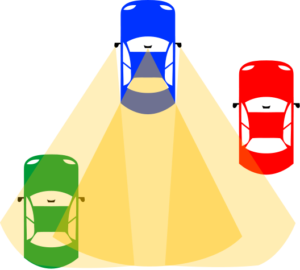Spatial Awareness in Driving
Written By | Doreen Almirol | 20+ years CA DMV Licensed Driving Instructor
Spatial awareness is the bedrock of safe and confident driving, influencing every maneuver from navigating tight spots to executing precise parking.
In this article, we will explore how to judge spatial awareness in key driving scenarios: Safe Maneuvering, Confident Parking, making Effective Lane Changes, and Navigating Narrow Roads.
This blog may contain affiliate links, and if you make a purchase through these links, we may or may not earn a commission at no extra cost to you.
1 | Safe Maneuvering
Understand Your Vehicle’s Dimensions
Begin by familiarizing yourself with the dimensions of your vehicle. Knowing its length, width, and height is essential for safe maneuvering, allowing you to gauge clearances accurately.
Use Reference Points
Utilize fixed points on your vehicle, such as side mirrors or specific markings, as reference points. Align these with the environment to judge distances effectively during turns and maneuvers.
Practice in Controlled Environments
Mastering spatial awareness requires practice. Start in empty parking lots or quiet streets to perform basic maneuvers like turns and stops. Gradually progress to more complex scenarios as your comfort grows.
2 | Confident Parking
Visualize Maneuvers in Advance
Before attempting parking, visualize the maneuver in your mind. Envision the path your vehicle will take, helping you anticipate and navigate spatial challenges more confidently. Utilize reference points.
Gradual Progression in Parking
Master different parking scenarios progressively. Begin with straightforward situations like straight-in parking before advancing to angle parking and parallel parking. Each step builds spatial awareness.
Utilize Parking Assistance Technology
Modern vehicles often come equipped with parking sensors and cameras. Use these tools as aids, but don’t solely rely on them. Regularly practice without assistance to hone your spatial awareness skills.
3 | Effective Lane Changes
Develop Peripheral Vision
Expand your awareness beyond what’s directly in front of you. Utilize your peripheral vision to assess the positions of vehicles on the sides, crucial for making safe and effective lane changes.
Stay Aware of Blind Spots
Regularly check your mirrors and perform shoulder checks to identify blind spots. Being aware of these areas ensures safe lane changes without the risk of colliding with unseen vehicles.
4 | Navigating Narrow Roads
Adapt to Different Driving Conditions:
Spatial awareness evolves with diverse conditions. Practice on narrow roads, adapting to tight spaces and varied layouts. This adaptability enhances your ability to navigate challenging environments.
Use Reference Points for Clearances:
Judging clearances on narrow roads is crucial. Utilize reference points on your vehicle to assess proximity to curbs, parked cars, or oncoming traffic.
Spatial awareness is a dynamic skill that evolves with practice, experience, and a deliberate effort to understand your vehicle’s relationship with its environment. By incorporating these practical tips into your driving routine, you can enhance your spatial awareness and navigate the roads with increased safety and confidence.
Remember, mastering spatial awareness is an ongoing process, and each practice session contributes to your growth as a proficient and confident driver. Safe travels on your road to mastering spatial awareness!
Ready to Drive with Confidence?
Struggling with spatial awareness? Sign up for driving lessons today! Expert guidance, personalized tips, and structured practice will boost your confidence behind the wheel.
Don’t let challenges hold you back—take control of your driving journey now. Sign up and conquer the road with ease!





